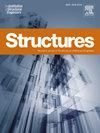Elastic equivalent multi-bar models for corrugated steel plate shear walls in structural analysis
IF 4.3
2区 工程技术
Q1 ENGINEERING, CIVIL
引用次数: 0
Abstract
The corrugated steel plate shear wall (CPSW) embedded within frames demonstrates high shear-bearing capacity and excellent energy dissipation performance even with relatively thin plates. It is essential to calculate the internal elastic forces and deformations in structural design. However, modeling CPSWs with shell elements results in high computational costs, making it necessary to develop an equivalent simplified model for CPSWs. To this end, based on the shear-bearing mechanism of CPSWs, the CPSW is equivalently simplified into a model of densely spaced beams or columns connected to the frame’s beams and columns, termed multi horizontal bar or multi vertical bar model. Multi-bars model with fixed connection to beams or columns behaving as multi-bar framing model is established to simulate shear-resistant behavior of CPSWs based on almost zero compressive stiffness in the direction perpendicular to the corrugations. The basic methodology of this research is to ensure that the initial equivalent stiffness of the multi-bar frame model aligns precisely with that of the refined finite element model (FEM). This alignment requires defining fundamental principles for determining the quantity and stiffness properties of both multi horizontal bars and multi vertical bars in the model. First, CPSW examples covering typical engineering dimensions are designed. The elastic load–lateral displacement curves under horizontal shear are subsequently calculated separately for the multi-bar frame model and the refined shell element model. From the comparison between these curves, the initial shear stiffness coefficients are identified, followed by deriving a formula to calculate the initial shear stiffness through parameter fitting. Comparative results between the two models indicate that the simplified equivalent model for calculating the elastic internal forces and lateral displacements of frame-CPSW structures not only streamlines structural analysis and enhances computational efficiency but also satisfies the accuracy standards required for structural strength design. Therefore, this model can be reliably applied in overall elastic calculations in structural design.
波纹钢板剪力墙结构分析中的弹性等效多杆模型
框架内嵌波纹钢板剪力墙具有较高的抗剪承载力和较薄的耗能性能。在结构设计中,内部弹性力和变形的计算是必不可少的。然而,利用壳单元对cpsw进行建模的计算成本很高,因此有必要为cpsw开发一个等效的简化模型。为此,根据CPSW的剪切承载机制,将CPSW等效简化为与框架梁柱相连的密距梁或柱模型,称为多横杆或多竖杆模型。建立了基于多杆框架模型的梁或柱固定连接多杆模型,模拟了垂直于波纹方向压刚度几乎为零的cpsw的抗剪性能。本研究的基本方法是确保多杆框架模型的初始等效刚度与精化有限元模型的初始等效刚度精确对齐。这种对齐需要定义确定模型中多个水平杆和多个垂直杆的数量和刚度特性的基本原则。首先,设计了涵盖典型工程尺寸的CPSW示例。随后分别计算了多杆框架模型和精壳单元模型在水平剪切作用下的弹性荷载-侧向位移曲线。通过对两曲线的对比,确定了初始剪切刚度系数,并通过参数拟合推导出初始剪切刚度计算公式。两种模型的对比结果表明,框架- cpsw结构弹性内力和侧向位移的简化等效模型不仅简化了结构分析,提高了计算效率,而且满足了结构强度设计的精度要求。因此,该模型可以可靠地应用于结构设计中的整体弹性计算。
本文章由计算机程序翻译,如有差异,请以英文原文为准。
求助全文
约1分钟内获得全文
求助全文
来源期刊

Structures
Engineering-Architecture
CiteScore
5.70
自引率
17.10%
发文量
1187
期刊介绍:
Structures aims to publish internationally-leading research across the full breadth of structural engineering. Papers for Structures are particularly welcome in which high-quality research will benefit from wide readership of academics and practitioners such that not only high citation rates but also tangible industrial-related pathways to impact are achieved.
 求助内容:
求助内容: 应助结果提醒方式:
应助结果提醒方式:


